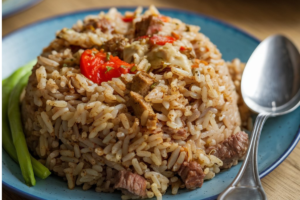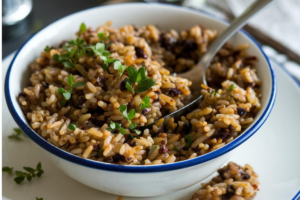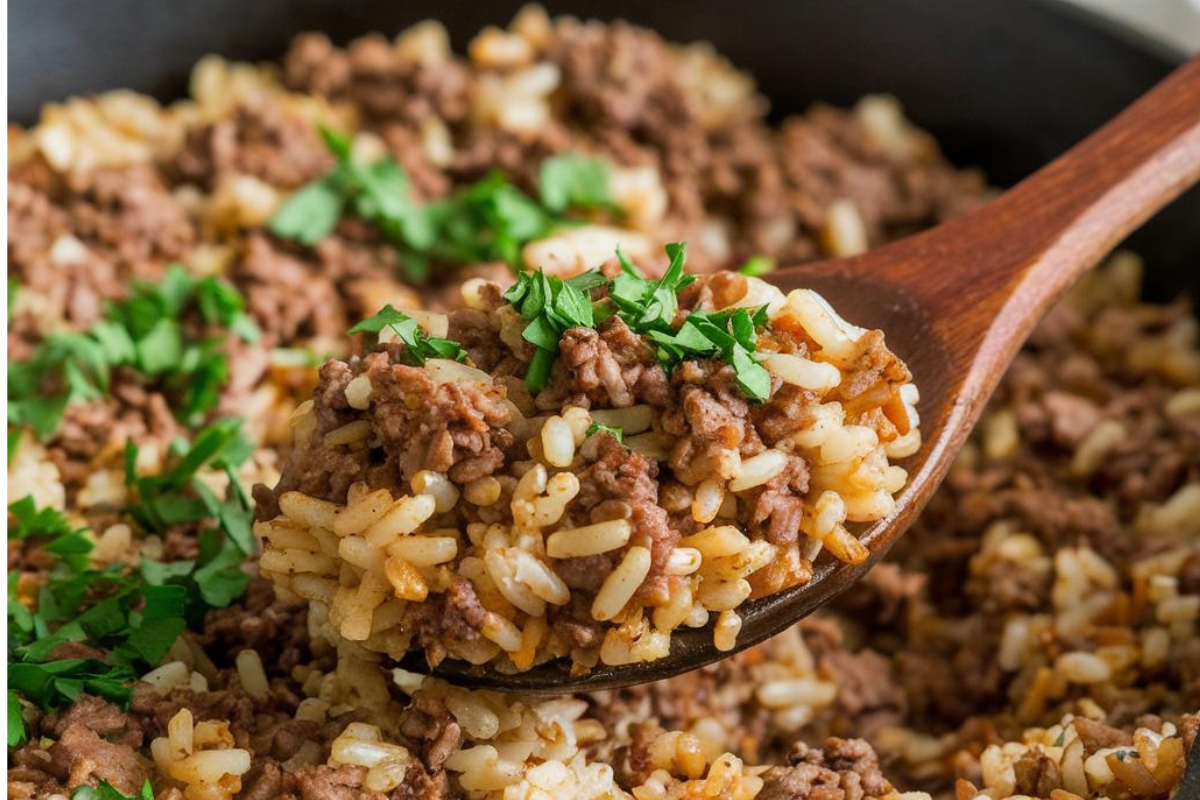Dirty rice is a beloved dish deeply rooted in Southern culinary traditions, particularly within Cajun and Creole cuisine. Known for its rich flavors and “dirty” appearance, this dish is a staple in many households across the United States. However, with the growing focus on healthy eating, many are questioning whether dirty rice is a nutritious option. In this article, we will explore the ingredients, nutritional content, potential health benefits, and concerns surrounding dirty rice. We’ll also offer tips on how to make this classic dish healthier without sacrificing its authentic taste.
Understanding Dirty Rice: Origins and Ingredients
Dirty rice is a flavorful dish that originated in Louisiana, deeply intertwined with the region’s history and culture. The name “dirty rice” comes from the dish’s appearance, which is caused by the inclusion of finely chopped meats, typically liver or sausage, that give the rice a “dirty” color. The dish is traditionally made with white rice, a mix of meats, and a combination of the “holy trinity” of Cajun cooking: bell peppers, onions, and celery.
Key Ingredients of Dirty Rice:
- White Rice: The base of the dish, providing carbohydrates and serving as the canvas for the rich flavors.
- Meats: Often includes liver, sausage, ground beef, or pork, contributing to the dish’s protein content.
- Vegetables: Bell peppers, onions, and celery add texture, flavor, and nutrients.
- Seasonings: A blend of Cajun spices such as paprika, cayenne pepper, thyme, and garlic powder gives the dish its signature taste.
Nutritional Profile of Dirty Rice
To determine whether dirty rice is healthy, it’s essential to break down its nutritional components. Here’s what a typical serving of dirty rice might contain:
- Calories: Approximately 350-500 calories per serving, depending on the specific recipe and portion size.
- Protein: 12-18 grams, primarily from the meats included in the dish.
- Fat: 18-25 grams, with a mix of saturated and unsaturated fats, largely influenced by the type of meat used.
- Carbohydrates: 45-60 grams, mainly from the rice, providing a significant source of energy.
- Fiber: 2-4 grams, depending on the amount of vegetables and the type of rice used.
- Vitamins and Minerals: Dirty rice is a good source of iron (due to the liver) and provides essential vitamins such as vitamin A, vitamin C, and B vitamins from the vegetables.
This nutritional breakdown shows that dirty rice can be a hearty meal, providing a balanced mix of macronutrients. However, the calorie and fat content can vary significantly based on the recipe, making portion control and ingredient selection crucial.
Health Benefits of Dirty Rice

Despite its reputation as a rich and indulgent dish, dirty rice does offer several health benefits:
1. Protein-Rich Meal:
The inclusion of meats like liver, sausage, or ground beef provides a significant amount of protein, which is essential for muscle growth, repair, and overall body function. Protein also plays a crucial role in maintaining a healthy immune system and producing enzymes and hormones.
2. Iron Content:
Liver, a common ingredient in dirty rice, is an excellent source of iron, a mineral vital for the production of hemoglobin and the prevention of anemia. Iron is also important for energy production and cognitive function.
3. Vitamin-Rich Vegetables:
The “holy trinity” of Cajun cooking—bell peppers, onions, and celery—adds a substantial amount of vitamins and minerals to the dish. Bell peppers are particularly rich in vitamin C, which supports immune health and skin vitality. Onions provide antioxidants like quercetin, which has anti-inflammatory properties, and celery offers fiber, vitamin K, and potassium.
4. Balanced Macronutrient Profile:
When made with the right ingredients, dirty rice can provide a balanced mix of carbohydrates, protein, and fats, making it a satisfying and energy-sustaining meal.
Potential Health Concerns with Dirty Rice
While dirty rice has its benefits, there are also potential health concerns to be aware of:
1. High Calorie and Fat Content:
Dirty rice can be calorie-dense, especially when made with fatty meats like sausage or when cooked in large amounts of oil or butter. A high intake of saturated fats, common in many traditional dirty rice recipes, can lead to an increased risk of heart disease and other cardiovascular issues.
2. High Sodium Levels:
Many dirty rice recipes call for seasoned meats, salt, and commercial broths, all of which can contribute to high sodium levels. Excessive sodium intake is linked to high blood pressure, heart disease, and stroke. For those looking to reduce their sodium intake, opting for homemade broth and low-sodium seasoning alternatives is recommended. You can learn more about low-sodium seasoning alternatives and how they can enhance the flavor of your meals without the added salt.
3. Dietary Restrictions:
For individuals with specific dietary needs, such as those following a gluten-free or low-fat diet, traditional dirty rice might not be suitable without modifications. It’s important to choose gluten-free meats and seasonings if you need to avoid gluten. Additionally, those managing their fat intake should consider using lean meats and reducing the amount of added fats in the recipe.
Making an Healthy Dirty Rice

If you’re a fan of dirty rice but concerned about its health implications, there are several ways to make this dish healthier without losing its delicious flavor:
1. Choose Lean Meats:
Substitute traditional fatty meats like sausage and liver with leaner options such as ground turkey, chicken, or even lean cuts of beef. This change will significantly reduce the saturated fat content while still providing ample protein.
2. Opt for Brown Rice:
Using brown rice instead of white rice is one of the simplest ways to boost the nutritional value of dirty rice. Brown rice is a whole grain, meaning it retains the bran and germ, which are rich in fiber, vitamins, and minerals. The increased fiber content in brown rice aids digestion, helps maintain blood sugar levels, and keeps you feeling fuller for longer. To learn more about the benefits of whole grains, consider reading up on the nutritional benefits of brown rice.
3. Add More Vegetables:
Increase the vegetable content in your dirty rice by adding nutrient-dense options like spinach, zucchini, or carrots. These vegetables add volume to the dish without significantly increasing the calorie count, while also boosting the vitamin, mineral, and fiber content.
4. Reduce Sodium:
Prepare your dirty rice with homemade or low-sodium broth and be mindful of the amount of added salt. You can enhance the flavor with herbs and spices like garlic, thyme, and cayenne pepper instead of relying on salt-heavy seasonings.
5. Consider Plant-Based Alternatives:
For a vegetarian or vegan dirty rice, swap meat with plant-based proteins like lentils, black beans, tofu, or tempeh. These options reduce fat and add new textures and flavors, making the dish suitable for more diets.
By making these simple adjustments, you can enjoy a healthier version of dirty rice that still delivers on taste and satisfaction.
Comparing Dirty Rice to Other Popular Rice Dishes
To fully appreciate the healthiness of dirty rice, it’s useful to compare it to other well-known rice dishes such as jambalaya, paella, and fried rice.
1. Jambalaya:
Like dirty rice, jambalaya is a staple of Southern cuisine, particularly in Louisiana. Jambalaya typically includes rice, a variety of meats (such as chicken, sausage, and shrimp), and a mix of vegetables. While jambalaya is higher in protein due to the inclusion of multiple meats and seafood, it can also be high in fat and sodium. However, when made with lean proteins and plenty of vegetables, it can be a balanced and nutritious meal.
2. Paella:
Paella, a traditional Spanish dish, is another rice-based meal that often includes seafood, chicken, and vegetables, all cooked in a saffron-infused broth. It’s generally lower in fat compared to dirty rice and can be quite nutrient-rich, especially when made with a variety of seafood, which provides omega-3 fatty acids. However, paella can also be high in sodium, depending on the type of broth and seasonings used.
3. Fried Rice:
Fried rice, a popular dish in many Asian cuisines, is typically made with day-old rice, vegetables, eggs, and sometimes meat or seafood, all stir-fried in oil and soy sauce. It’s often high in calories and fat due to the cooking oil and can be very high in sodium due to the soy sauce. While tasty, it tends to be less healthy than dirty rice when considering traditional recipes.
Overall, dirty rice can be considered healthier than fried rice but may be comparable to jambalaya and paella in terms of nutritional value, depending on how each dish is prepared.
FAQs
1. Is Dirty Rice High in Calories?
Yes, dirty rice can be high in calories, especially when prepared with traditional ingredients like sausage, liver, and white rice. However, by using lean meats and brown rice, you can reduce the calorie content while still enjoying the dish.
2. What Are the Healthiest Ingredients to Use in Dirty Rice?
The healthiest dirty rice ingredients are lean proteins like ground turkey or chicken, brown rice for fiber, and a variety of nutrient-rich vegetables. Additionally, using low-sodium broth and seasonings can help reduce the sodium content.
3. Can Dirty Rice Be Part of a Balanced Diet?
Absolutely! Dirty rice can be part of a balanced diet when consumed in moderation and made with healthier ingredients. Pair it with a side salad or steamed vegetables to create a well-rounded meal.
4. Is Dirty Rice Gluten-Free?
Dirty rice can be gluten-free if all the ingredients used are free from gluten, including the meats, broths, and seasonings. Always check labels to ensure that no gluten-containing ingredients are included.
5. How Often Should You Eat Dirty Rice?
Dirty rice can be enjoyed occasionally as part of a balanced diet. If you’re monitoring your calorie, fat, or sodium intake, enjoy it in moderation and consider a healthier version.
Conclusion
In conclusion, dirty rice can be both a delicious , healthy and nutritious dish, depending on how it is prepared. By choosing lean meats, brown rice, and plenty of vegetables, you can make dirty rice a healthy part of your diet. Though it has potential health concerns like high calories and sodium, these can be easily mitigated with simple adjustments. Whether you prefer traditional recipes or want to explore healthier alternatives, dirty rice offers versatile and flavorful options for various dietary preferences.

